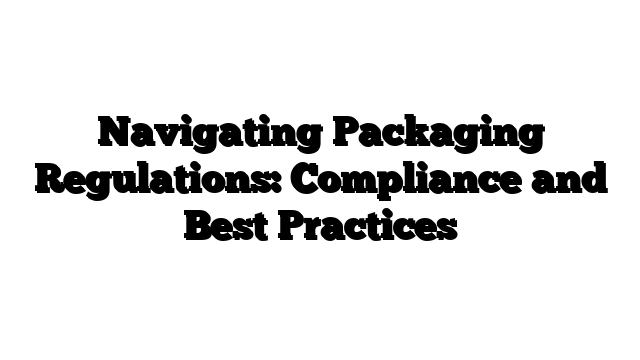Packaging is a critical aspect of product design and marketing, serving as the first point of contact between a consumer and a product. It not only influences a consumer’s purchasing decision but also plays a crucial role in protecting the product during transportation and storage.
However, the world of packaging is not just about creativity and aesthetics; it is also subject to numerous regulations and standards designed to ensure consumer safety, environmental sustainability, and fair trade practices.
Here, we will explore the complexities of packaging regulations, the importance of compliance, and best practices for navigating this challenging landscape.
The Regulatory Landscape
Packaging regulations are diverse and multifaceted, covering a wide range of aspects, from material selection to labeling requirements.
These regulations are typically enforced at the national, regional, and even local levels, making compliance a complex endeavor for businesses involved in packaging.
Environmental Regulations:
Packaging materials and waste are at the forefront of environmental concerns. Governments and regulatory bodies worldwide have introduced regulations aimed at reducing the environmental impact of packaging.
For instance, many countries have established recycling targets and mandated the use of eco-friendly materials. Compliance with these regulations often requires businesses to rethink their packaging materials and practices, favoring sustainable and biodegradable options.
Health and Safety Regulations:
Packaging must ensure the safety of consumers. Regulations in this category address issues such as child-resistant packaging for specific substances, the use of food-safe materials even for packaging pet food products, and proper labeling of allergens and nutritional information. Failure to meet these requirements can lead to serious legal and financial consequences.
Weight and Volume Regulations:
Many countries have laws that specify the minimum and maximum weights and volumes for packaging, which are intended to protect consumers from deceptive packaging practices. These regulations often vary between jurisdictions, adding complexity to packaging compliance efforts.
Labeling and Information Regulations:
Packaging must provide clear and accurate information to consumers.
Labeling requirements can include ingredient lists, instructions for use, product certifications, and country-of-origin information. Non-compliance with these regulations can lead to product recalls and damage to a brand’s reputation.
Transportation and Handling Regulations:
Packaging plays a significant role in the logistics and supply chain.
Regulations related to the transportation of goods often specify packaging requirements to ensure safe and efficient handling. This is especially important for delicacies such as when packaging jerky and other preserved foods.
Failing to comply with these regulations can result in damaged products and supply chain disruptions.
Trade and Import/Export Regulations:
For businesses engaged in international trade, packaging regulations extend to customs and import/export requirements.
These regulations are crucial for avoiding costly delays and potential legal issues when shipping products across borders.
Compliance: Why It Matters
The consequences of non-compliance with packaging regulations can be severe. Ignoring these rules can result in legal penalties, product recalls, loss of customer trust, and damage to a company’s reputation. Here’s why compliance is so important:
Legal Consequences:
Violating packaging regulations can lead to fines, sanctions, and even legal action. Authorities take these rules seriously, and ignorance of the law is rarely a valid defense.
Product Recalls:
Non-compliant packaging can lead to product recalls, which can be expensive and detrimental to a company’s brand. The costs of recall, replacement, and damage control can be substantial.
Consumer Trust:
Compliance with packaging regulations is essential for building and maintaining consumer trust. When consumers perceive a company as responsible and ethical, they are more likely to choose its products over competitors.
Brand Reputation:
A reputation for compliance and ethical business practices can set a company apart from its competitors. Non-compliance can tarnish a brand’s reputation, potentially resulting in long-term damage to its image and profitability.
Best Practices for Navigating Packaging Regulations
Navigating the complex world of packaging regulations requires careful planning and a commitment to compliance. Here are some best practices to help businesses meet regulatory requirements effectively:
Stay Informed:
The regulatory landscape is constantly evolving. To remain compliant, businesses must stay informed about changes in packaging regulations at the local, national, and international levels. This may involve regular consultation with legal experts, industry associations, and government agencies.
Conduct Regulatory Assessments:
Regularly assess the regulatory requirements applicable to your products and packaging. This includes materials, labeling, weight and volume restrictions, environmental standards, and any other relevant regulations. Develop a comprehensive understanding of the rules that affect your specific industry.
Collaborate with Experts:
Seeking advice from legal experts and consultants with expertise in packaging regulations can be invaluable. These professionals can help your business navigate the regulatory landscape and make informed decisions to ensure compliance.
Material Selection:
Choose packaging materials that align with environmental regulations. Whenever possible, opt for sustainable, recyclable, or biodegradable materials. This not only demonstrates a commitment to environmental responsibility but can also appeal to eco-conscious consumers.
Design with Compliance in Mind:
When designing packaging, consider regulatory requirements from the outset. Ensure that all necessary information can be presented clearly on the label, and that materials and construction meet health and safety standards.
Conduct Product Testing:
Rigorous product testing can help identify potential compliance issues early in the development process. This can save a significant amount of time and resources by preventing non-compliant products from reaching the market.
Keep Meticulous Records:
Maintain detailed records of all packaging-related compliance activities. This includes documentation of material sourcing, test results, regulatory assessments, and any correspondence with regulatory authorities. Having a comprehensive record can be a valuable asset in demonstrating compliance in case of a regulatory audit.
Implement a Continuous Improvement Process:
Regulatory compliance is an ongoing commitment. Continuously monitor and update your packaging practices and materials as regulations change or your business evolves. This proactive approach can help you stay ahead of compliance challenges.
Train Your Team:
Ensure that your staff is well-versed in packaging regulations and compliance requirements. Offer training programs and resources to keep everyone up to date and accountable for compliance-related responsibilities.
Conclusion
Packaging regulations are a crucial aspect of doing business in today’s global marketplace. Failing to comply with these regulations can lead to legal consequences, product recalls, and damage to a company’s reputation.
To navigate the complex landscape of packaging regulations effectively, businesses must stay informed, collaborate with experts, and make compliance a top priority in their packaging strategies.
By adopting best practices and demonstrating a commitment to responsible packaging, businesses can not only avoid legal troubles but also build consumer trust and enhance their brand’s reputation in a competitive marketplace.
James Martin is a passionate writer and the founder of OnTimeMagazines & EastLifePro. He loves to write principally about technology trends. He loves to share his opinion on what’s happening in tech around the world.



